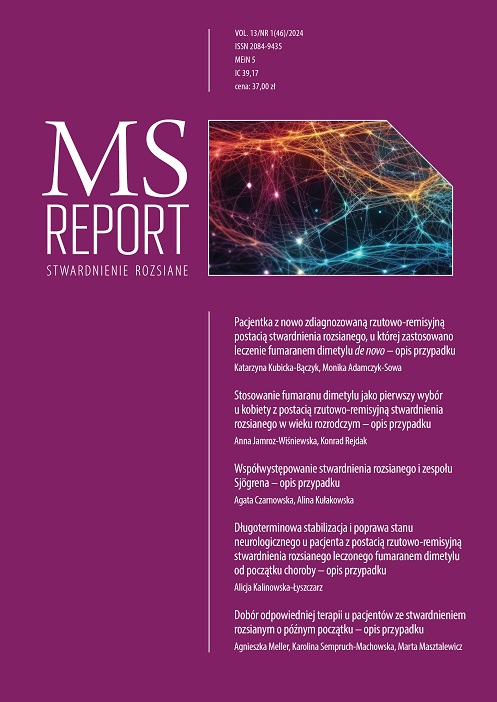Wieloletnia skuteczna terapia stwardnienia rozsianego fumaranem dimetylu u pacjenta z wszczepionym układem stymulującym serce – opis przypadku Opis przypadku
##plugins.themes.bootstrap3.article.main##
Abstrakt
W artykule przedstawiono opis przypadku 46-letniego pacjenta, u którego w 2011 r. rozpoznano postać rzutowo-remisyjną stwardnienia rozsianego. Chory jest obciążony kardiologicznie. W 2015 r. miał wszczepiony układ stymulujący serce z powodu objawowego bloku przedsionkowo-komorowego II stopnia. W 2016 r. zastosowano fumaran dimetylu jako kolejną terapię modulującą przebieg choroby w związku z nietolerancją i nieskutecznością wcześniejszych terapii. W ciągu 7 lat leczenia fumaranem dimetylu uzyskano brak aktywności choroby (NEDA 3). Z powodu implantowanego układu stymulującego serce wykonywanie badań metodą rezonansu magnetycznego wymaga współpracy kardiologa, co jest możliwe dzięki leczeniu pacjenta w dużym, wielospecjalistycznym ośrodku klinicznym.
##plugins.themes.bootstrap3.article.details##
Copyright © by Medical Education. All rights reserved.
Bibliografia
2. Giovannoni G, Tomic D, Bright JR et al. „No evident disease activity”: The use of combined assessments in the management of patients with multiple sclerosis. Mult Scler. 2017; 23(9): 1179-87. http://doi.org/10.1177/1352458517703193.
3. Sorensen PS, Sellebjerg F, Hartung HP et al The apparently milder course of multiple sclerosis: changes in the diagnostic criteria, therapy and natural history. Brain. 2020; 143(9): 2637-52. http://doi.org/10.1093/brain/awaa145.
4. Buron MD, Chalmer TA, Sellebjerg F et al. Comparative effectiveness of teriflunomide and dimethyl fumarate – A nationwide cohort study. Neurology. 2019; 92: 1-10. http://doi.org/10.1212/WNL.0000000000007314.
5. Braune S, Grimm S, van Hövell P et al.; NTD Study Group. Comparative effectiveness of delayed-release dimethyl fumarate versus interferon, glatiramer acetate, teriflunomide, or fingolimod: results from the German NeuroTransData registry. J Neurol. 2018; 265(12): 2980-92. http://doi.org/10.1007/s00415-018-9083-5.
6. Ontaneda D, Nicholas J, Carraro M et al. Comparative effectiveness of dimethyl fumarate versus fingolimod and teriflunomide among MS patients switching from first-generation platform therapies in the US. Mult Scler Relat Disord. 2019; 27: 101-11. http://doi.org/10.1016/j.msard.2018.09.038.
7. Prosperini L, Haggiag S, Ruggieri S et al. Dimethyl Fumarate or Teriflunomide for Relapsing-Remitting Multiple Sclerosis: A Meta-analysis of Post-marketing Studies. Neurotherapeutics. 2023; 20(5): 1275-83. http://doi.org/10.1007/s13311-023-01416-x.
8. Fox RJ, Chan A, Zhang A et al. Comparative effectiveness using a matching-adjusted indirect comparison between delayed-release dimethyl fumarate and fingolimod for the treatment of multiple sclerosis. Curr Med Res Opin. 2017; 33(2): 175-83. http://doi.org/10.1080/03007995.2016.1248380.
9. Lorscheider J, Benkert P, Lienert C et al. Comparative analysis of dimethyl fumarate and fingolimod in relapsing-remitting multiple sclerosis. J Neurol. 2021; 268(3): 941-9. http://doi.org/10.1007/s00415-020-10226-6.
10. Freedman MS, Devonshire V, Duquette P et al. Treatment Optimization in Multiple Sclerosis: Canadian MS Working Group Recommendations. Can J Neurol Sci. 2020; 47(4): 437-55. http://doi.org/10.1017/cjn.2020.66.
11. Saccà F, Lanzillo R, Signori A et al. Determinants of therapy switch in multiple sclerosis treatment-naïve patients: A real-life study. Mult Scler. 2019; 25(9): 1263-72. http://doi.org/10.1177/1352458518790390.

